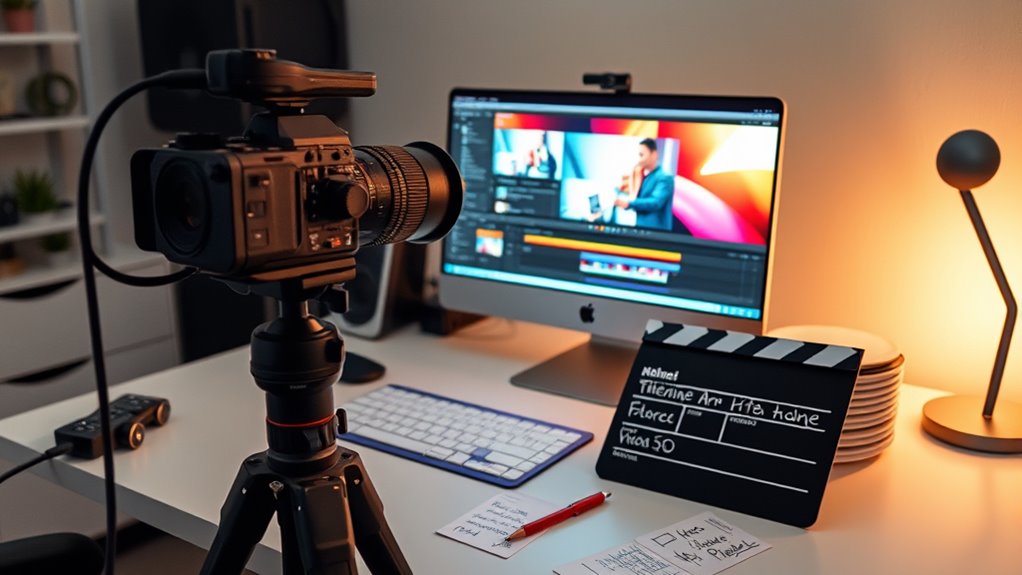When releasing your aftermovie, plan to launch it within a few weeks after the event to keep the excitement alive. Make certain you secure all necessary rights for music, footage, and performances to avoid legal issues, and give clear credits to everyone involved. Use the right platforms like YouTube or Vimeo for maximum reach, and customize content for each one’s requirements. Learning more will help you navigate the perfect timing, rights, and credits for a successful release.
Key Takeaways
- Secure all content rights and necessary licenses before editing and publishing your aftermovie.
- Plan a release timeline within a few weeks post-event to maximize audience engagement.
- Prepare multiple versions optimized for different platforms’ specifications and audiences.
- Include proper credits for performers, contributors, and licensed content to avoid copyright issues.
- Use snippets or highlights on social media to generate buzz and drive viewers to the full aftermovie.

Releasing your aftermovie is a vital step in sharing the excitement and memories of your event with the world. It’s the moment when all your planning pays off, giving viewers a glimpse of the energy, passion, and atmosphere you worked so hard to create. But before you hit “publish,” it’s essential to consider copyright concerns and the best distribution channels to ensure your video reaches your audience smoothly and legally. Copyright issues can be tricky, especially if your footage includes clips of music, performances, or other copyrighted material. If you don’t address these concerns upfront, you risk takedown notices, legal disputes, or your video being removed from platforms. To avoid these pitfalls, make sure you have the rights to all content in your aftermovie. This might involve securing licenses for music, getting permission from performers or speakers, or using royalty-free assets. Once you’ve secured the necessary rights, you can confidently choose your distribution channels. Platforms like YouTube, Vimeo, or social media sites are popular options, but each comes with its own rules and audience. For example, YouTube’s Content ID system automatically scans videos for copyrighted material, so it’s crucial to be cautious about what you upload. Vimeo tends to be more lenient with original content, making it a good choice if your footage is entirely your own. Social media channels like Instagram or Facebook offer quick, easy ways to share your video, but they may compress your footage or restrict certain features. When selecting your channels, think about your target audience and how they prefer to consume content. If you’re aiming for a broader reach, a multi-platform approach can work best—you upload a full version on YouTube, then share snippets or highlights on Instagram or TikTok to generate buzz. Keep in mind that each platform has its own specifications for video length and format, so prepare different versions if needed. Also, consider adding captions, watermarks, or branding to protect your work and ensure viewers recognize your event. Timing is key—releasing your aftermovie too soon might mean incomplete editing, but waiting too long could dampen excitement. Typically, aim to publish within a few weeks, once your video is polished and all rights are secured. Additionally, understanding juice extraction techniques can help you incorporate fresh, engaging content into your promotional material. By carefully navigating copyright concerns and choosing the right distribution channels, you maximize your aftermovie’s impact and ensure it reaches your audience legally and effectively. This way, your memories will inspire, entertain, and resonate with viewers long after the event has ended.
Frequently Asked Questions
How Do I Handle Licensing for Third-Party Footage?
You should secure proper footage permissions by contacting the rights holders directly or using licensed stock footage. For music licensing, guarantee you obtain clear rights for any soundtrack included. Always document all permissions and licenses. Double-check that your licensing covers both the footage and music, and keep records in case of disputes. This way, you avoid copyright issues and ensure your aftermovie is legally sound.
What Are Common Mistakes in Aftermovie Releases?
A common mistake is neglecting music licensing, which can lead to takedowns or legal issues. You might also overlook securing event permissions, risking copyright claims or removal. Always verify that you have proper rights for all content, including music and footage, and double-check event permissions. Failing to do so can delay your release or cause disputes, so plan ahead, and guarantee all licenses and permissions are in place before publishing your aftermovie.
How Long Should I Wait Before Releasing My Aftermovie?
You should wait at least 4 to 6 weeks after the event before releasing your aftermovie. This allows time for music licensing agreements to be secured, guaranteeing you won’t face legal issues, and helps build anticipation, boosting audience engagement. Rushing the release might harm your credibility or lead to copyright problems. Planning ahead ensures your aftermovie is polished, legally compliant, and maximizes impact on your viewers.
Can I Monetize My Aftermovie on Social Platforms?
Yes, you can monetize your aftermovie on social platforms, but you need to follow their policies and use effective monetization strategies. Check each platform’s social media policies to guarantee you comply with their rules, like copyright and content guidelines. You might consider ad revenue, sponsored content, or fan support to generate income. Always review platform-specific policies before monetizing, so you avoid issues and maximize your earnings.
What Are Best Practices for Crediting Contributors?
Properly credit contributors by clearly citing guest appearances and recognizing audience contributions. You should mention everyone involved, from videographers to performers, ensuring their efforts are acknowledged. Use consistent, thorough captions and tags across social platforms, emphasizing their roles. By giving visible recognition, you foster goodwill, boost professionalism, and build valuable relationships. Remember, crediting correctly demonstrates respect and transparency, making your aftermovie more authentic and appreciated by both contributors and viewers alike.
Conclusion
Remember, timing is everything when releasing your aftermovie. Make sure you’ve secured your rights, given proper credits, and followed your timeline. When you do it right, your hard work shines and reaches the right audience. As the saying goes, “Better late than never,” but in this case, timely release maximizes impact. Stay organized, be patient, and trust your process—you’ll create a memorable showcase of your event’s magic.










